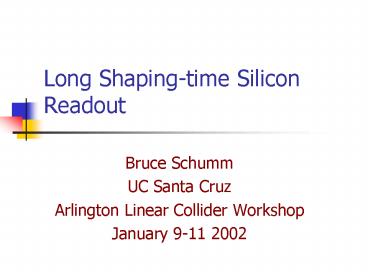Long Shaping-time Silicon Readout - PowerPoint PPT Presentation
Title:
Long Shaping-time Silicon Readout
Description:
Dave Dorfan, Christian Flacco, Alex Grillo, Hartmut ... Long Shaping-time Bail-out. Much of pulse simulation effort goes into `weighting ... – PowerPoint PPT presentation
Number of Views:22
Avg rating:3.0/5.0
Title: Long Shaping-time Silicon Readout
1
Long Shaping-time Silicon Readout
- Bruce Schumm
- UC Santa Cruz
- Arlington Linear Collider Workshop
- January 9-11 2002
2
Participants
Dave Dorfan, Christian Flacco, Alex Grillo,
Hartmut Sadrozinski, Bruce Schumm, Abe Seiden,
Ned Spencer, Lan Zhang
Also, a new post-doc (Gavin Nesom) will
probably join the effort in February
Potential external associates SLAC, LPNHE
Paris, CERN RD50
3
Motivation
Use of long shaping-time read- out (low noise)
plus exploitation of duty cycle permits
development of very long, thin ladders
Additionally, limited readout and servicing may
lead to very limited material budget in forward
region (down to 100 mrad)
4
Scope and Funding
Work funded via a two-year, 90,000 grant
from the DOE Advanced Detector RD Program (Will
need to enter regular LC funding game afterwards)
- 9 months graduate student support
- Chip fabrication
- Long-ladder development (existing sensors)
- Electronics servicing to ladder
5
Detailed Scope
Given the duration and magnitude of the support,
our deliverables will be
- Characterization of analog characteristics of
0.25 micron structures - Development of pulse development and electronic
simulation for shaping-time and readout- scheme
optimization - Demonstration of noise level commensurate with
readout of 2m ladder - Demonstration of x100 suppression of IR heating
loss - Min-i readout of 2m ladder
6
Pulse Development Simulation
Questions to be answered
- Sensor geometry and analog resolution required
to achieve lt7 um resolution - Effect of large magnetic fields
- Effects of oblique angles of incidence
- Optimal detector bias
7
Pulse Dev Sim Contd
Effects considered so far
- Landau fluctuations (SS_SIMSIDE, Jerry Lynch,
LBNL) - Electron diffusion
- Lorentz angle
- Space-charge repulsion
8
Long Shaping-time Bail-out
Much of pulse simulation effort goes into
weighting- field calculation (pulse-development
Greens Fnc)
However, integral of total charge is
- e if electron hits strip
- 0 if electron misses strip
In t --gt infinity limit, this is all you need to
worry about!
9
Electron Diffusion
Electron diffusion distribution given by
with diffusion constant given by
Effect of B field?
10
Space-charge Effects
Model deposition as uniform line of charge of
radius b and linear charge density l.
After separation of electrons, holes,
distribution expands conformally
11
Other Simulation Aspects
For now, assume mobilizing field that of
plane-biased diode (obscures details of field
near strips)
Variable inputs
- Detector geometry (pitch, thickness)
- Magnetic field
- Track parameters
- Detector bias
12
Potential Associations
Aurore Savoy-Navarro (LPNHE Paris)
Have discussed development of full-scale
ladder, readout for testbeam run
RD-50 (CERN, Mara Bruzzi)
Standing request for expert consultation
(Lorentz angle, diffusion and mobility vs. B,
etc.)
Possible exploration of Czochralski sensors
(large area, but leakage current needs work for
now)
13
Next Six Months
Immediately begin SPICE-level optimization of
shaping time (assuming 1-2 meter ladder)
Have already begun qualifying GLAST 8-channel
cutoff structures for use in 2m ladder
March begin mechanical design and construction
of two-meter ladder
Submission of prototype ASIC in June
14
Longer Term
- Summer 2003 measure noise and power consumption
characteristics - Fall 2003 (likely) begin design of 2nd
prototype chip based on accumulated experience - Winter 2004 begin development of realistic
prototype ladder, prepare for testbeam run - Summer 2004 testbeam studies begin to develop
scheme for back-end architecture
NOTE Project funded from DOE ADR program through
2003 afterwards, will need to switch to nominal
sources!































